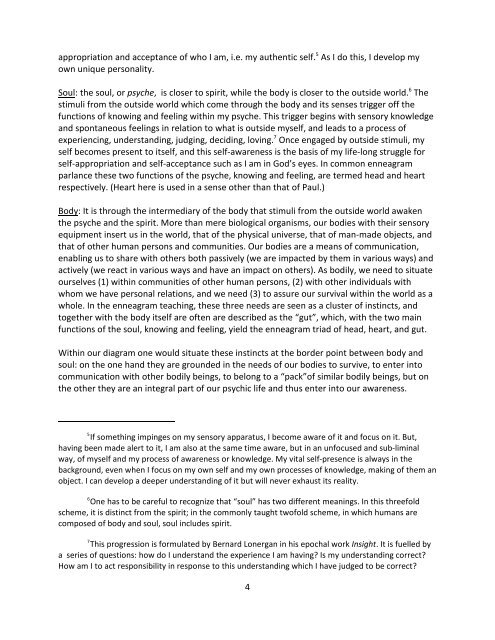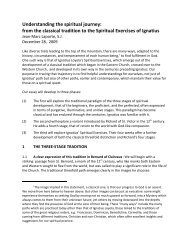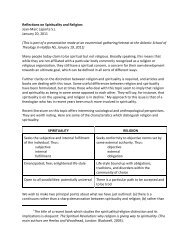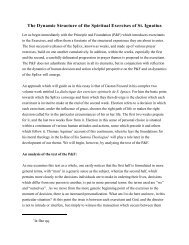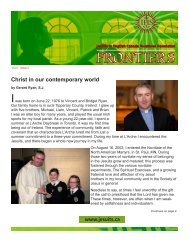A CHRISTIAN TRANSPOSITION OF THE ENNEAGRAM: WITH ...
A CHRISTIAN TRANSPOSITION OF THE ENNEAGRAM: WITH ...
A CHRISTIAN TRANSPOSITION OF THE ENNEAGRAM: WITH ...
You also want an ePaper? Increase the reach of your titles
YUMPU automatically turns print PDFs into web optimized ePapers that Google loves.
5<br />
appropriation and acceptance of who I am, i.e. my authentic self. As I do this, I develop my<br />
own unique personality.<br />
6<br />
Soul: the soul, or psyche, is closer to spirit, while the body is closer to the outside world. The<br />
stimuli from the outside world which come through the body and its senses trigger off the<br />
functions of knowing and feeling within my psyche. This trigger begins with sensory knowledge<br />
and spontaneous feelings in relation to what is outside myself, and leads to a process of<br />
7<br />
experiencing, understanding, judging, deciding, loving. Once engaged by outside stimuli, my<br />
self becomes present to itself, and this self-awareness is the basis of my life-long struggle for<br />
self-appropriation and self-acceptance such as I am in God’s eyes. In common enneagram<br />
parlance these two functions of the psyche, knowing and feeling, are termed head and heart<br />
respectively. (Heart here is used in a sense other than that of Paul.)<br />
Body: It is through the intermediary of the body that stimuli from the outside world awaken<br />
the psyche and the spirit. More than mere biological organisms, our bodies with their sensory<br />
equipment insert us in the world, that of the physical universe, that of man-made objects, and<br />
that of other human persons and communities. Our bodies are a means of communication,<br />
enabling us to share with others both passively (we are impacted by them in various ways) and<br />
actively (we react in various ways and have an impact on others). As bodily, we need to situate<br />
ourselves (1) within communities of other human persons, (2) with other individuals with<br />
whom we have personal relations, and we need (3) to assure our survival within the world as a<br />
whole. In the enneagram teaching, these three needs are seen as a cluster of instincts, and<br />
together with the body itself are often are described as the “gut”, which, with the two main<br />
functions of the soul, knowing and feeling, yield the enneagram triad of head, heart, and gut.<br />
Within our diagram one would situate these instincts at the border point between body and<br />
soul: on the one hand they are grounded in the needs of our bodies to survive, to enter into<br />
communication with other bodily beings, to belong to a “pack”of similar bodily beings, but on<br />
the other they are an integral part of our psychic life and thus enter into our awareness.<br />
5<br />
If something impinges on my sensory apparatus, I become aware of it and focus on it. But,<br />
having been made alert to it, I am also at the same time aware, but in an unfocused and sub-liminal<br />
way, of myself and my process of awareness or knowledge. My vital self-presence is always in the<br />
background, even when I focus on my own self and my own processes of knowledge, making of them an<br />
object. I can develop a deeper understanding of it but will never exhaust its reality.<br />
6<br />
One has to be careful to recognize that “soul” has two different meanings. In this threefold<br />
scheme, it is distinct from the spirit; in the commonly taught twofold scheme, in which humans are<br />
composed of body and soul, soul includes spirit.<br />
7<br />
This progression is formulated by Bernard Lonergan in his epochal work Insight. It is fuelled by<br />
a series of questions: how do I understand the experience I am having Is my understanding correct<br />
How am I to act responsibility in response to this understanding which I have judged to be correct<br />
4


